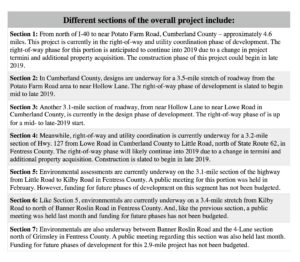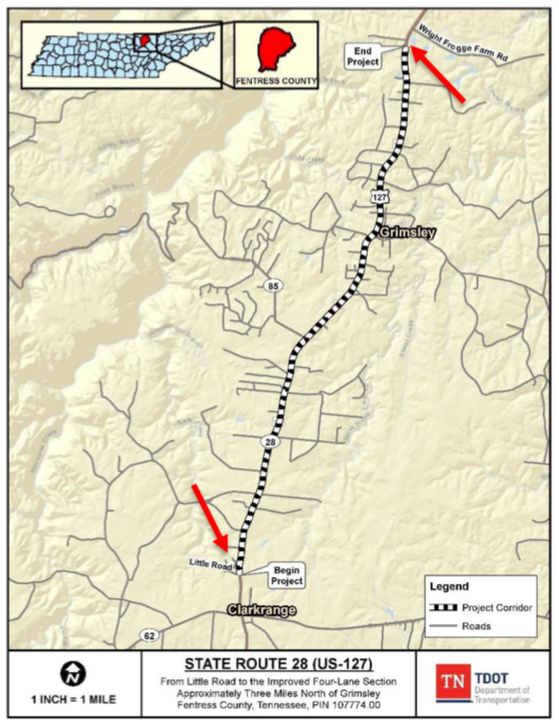By Amye Anderson
UCBJ Managing Editor
UPPER CUMBERLAND – A proposed project that would widen a busy 13-mile stretch of Hwy. 127 to a four-lane highway is being scaled back, at least for now, after more than two decades in the works. A lack of funding combined with the push to move forward with construction are the reasons TDOT reps have offered; saying they’re ready to proceed with building only two of the proposed four lanes.
Once complete, the new roadway would provide a direct link between Jamestown and Interstate 40 in Crossville as part of the Tennessee County Seat Connector Program; improving the traffic flow of the busy commerce route.
Last month, officials with the Tennessee Department of Transportation hosted separate public hearings with citizens of Cumberland and Fentress counties to provide progress updates to residents and address questions. A portion of the overall project has been identified as an IMPROVE Act project.
READ: Tennessee roadways get $297 million boost
At those meetings, TDOT reps announced the project would likely be scaled back; reducing the number of proposed lanes to be constructed at this time to two instead of four. During the public question-answer portion of the Cumberland County meeting, Dr. Maben Thompson asked why the agency was looking to scale the project down from a four to two lanes.
“We have spent 20 years working with this project,” Thompson told TDOT reps during the meeting. “So, I would like an explanation of what you mean by you can’t get traction on this project, and what it means, or what the efficiency of building a two-lane, and then having to come back and build the other side or modify what’s there to make it (a) four-lane; when the whole purpose of this project was for safety and to make it easier for us to get places here.”
Wes Hughen, TDOT Region 2 director of project development, says issues with the project’s environmental documents complicated matters.
“There’s an issue with our document, our environmental document” he said. “There’s an issue for the traffic warrants for the full four lanes. Right now, it doesn’t warrant the four lanes. We are trying our best to get something built as soon as we can, so we said we are coming back and we are working with our counterparts in the federal government to let us build the two lanes now, and as soon as it warrants, they are going to build the four lanes.”
Hughen says the construction of the two lanes now would likely remove existing horizontal and vertical issues and alleviate blind spots.
“We understand there’s a lot of accidents here,” Hughen told the crowd. “That’s why we are here. We tried to get here sooner, it’s just we have had a financial constraint that now we have overcome that hurdle for the time being.”
“We have the trouble of just getting federal funds to support what we are doing,” he added. “We are going ahead with the two-lane on the four-lane right-of-way. When it warrants the traffic, we’ll be right back here building the other two lanes.”
In order to complete the new two-lane, TDOT would construct both of the two lanes of the new road, maintaining traffic on the existing road. Once the new road is complete, traffic would then be moved over to the new roadway. While there will be two crossover points where construction will be taking place immediately adjacent to the road, the remainder of the construction will take place approximately 20- to 40-feet away from where drivers would be traveling.

According to Jennifer Flynn, TDOT Region 2 spokesperson, the proposed project will build a two-lane, undivided section with two 12-foot travel lanes, two 12-foot shoulders, with 10 feet being paved for the two projects involving Potato Farm Road in Cumberland County.
“The projects will maintain the corridor preservation and allow for future expansion,” Flynn explained.
The original plans for those two sections show a four-lane divided roadway, with two travel lanes each way, the median, and then the other edges.
In an effort to expedite progress on these projects, TDOT opted to consider a few changes to the original plans.
“These projects weren’t moving forward,” said Robert Rogers, a member of the TDOT project development office. “We weren’t getting traction on them. They weren’t moving forward in a way we liked, so we were looking for a way to get something moving on these projects sooner.”
In order to essentially kickstart the project, TDOT is proposing the construction of two of the future four lanes. Each section is subject to the sequence of steps necessary to get each portion to the construction phase. First, there’s the planning stage, followed by environmental, design, and right-of-way before work can begin toward construction.
Final right-of-way plans for the Potato Farm Road/Hollow Lane section are expected to be completed around this same time next year. Appraisals on affected properties could begin as early as May and acquisition could begin by August. Following that a timeline, final construction plans are due to the department in September 2020 and actual construction could begin as soon as Spring 2021. The Hollow Lane/Lowe Road section will also likely be scaled back to two lanes.
“Then, in the future, we’ll come back with the other two lanes on the other side,” Rogers said.
Those two sections could be constructed simultaneously, depending on funding availability.
“Actually, these we could probably do both at the same time, because in the phase construction what we are looking at is maintaining traffic on the existing road and building the two proposed new lanes farthest away from the existing road,” Rogers said.
The overall project is actually comprised of seven smaller projects; each a vital piece of the overall construction project spanning the 13-mile stretch of roadway connecting Cumberland and Fentress counties.
In Fentress County, original plans to build a four-lane divided roadway with 12-foot lanes and 12-foot shoulders with a 12-foot center turn lane have also been scaled back after expedited project delivery (EPD) review.
Design modifications proposed by EDP call for the construction of a three-lane roadway consisting of two 12-foot travel lanes – on in each direction, a 12-foot center turning lane, eight-foot shoulders. A southbound passing lane would be added between Little Road and near Kilby Road while a northbound passing lane would be added from near Kilby Road to north of Banner Roslin Road.
Before reaching the construction phase, each section must progress through a series of phases – planning, environmental, design, and right-of-way acquisition.
No official cost estimates have been revealed for this project.









